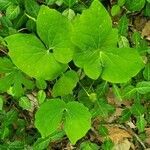Scape 1–2 dm at anthesis; petioles at first shorter than the scapes, later elongating to 2–5 dm; blades immature at anthesis, eventually 8–15 cm; fls white, 1–3 cm wide; fr 2–3 cm; 2n=12. Rich woods, preferring calcareous soil; w. N.Y. and s. Ont. to se. Minn., s. to Md. and Ala. Apr., May.
A herb. It grows 20-30 cm tall.







